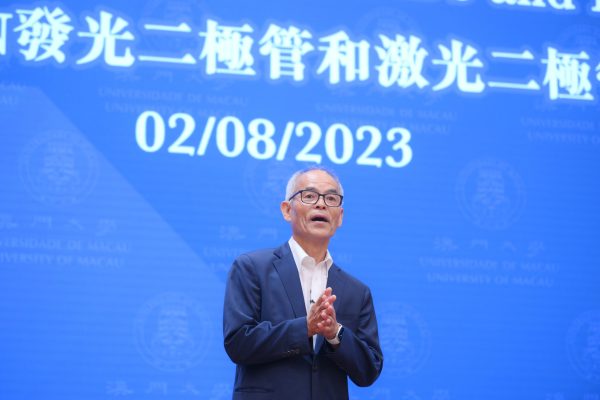News Express: Nobel laureate Shuji Nakamura shares background story and development of LED with UM members
新聞快訊:諾貝爾獎得主中村修二與澳大師生探討LED起源及發展

中村修二
Shuji Nakamura
諾貝爾獎得主中村修二與澳大師生探討LED起源及發展
澳門大學今(2)日舉辦榮譽博士講座,由2020年澳大榮譽理學博士、2014年諾貝爾物理學獎得主中村修二教授擔任主講者,以“高效藍色InGaN發光二極管和激光二極管的起源故事”為題發表演說,分享發明高效藍光二極管和激光二極管的經過,並展望未來的應用。中村修二教授亦與澳大管理及科研人員會面,探討前沿科研發展。
澳大校長代表、副校長許敬文致辭時表示,中村修二教授是可持續能源技術的先驅和傑出的固體材料物理學家,因發明藍色發光二極管(LED)而成為2014年諾貝爾物理學獎三位獲獎者之一。他的另一項重大成就是研發了藍色激光二極管,對於信息存儲的應用有著重大意義。其發明不僅為照明行業帶來革命性改變,也為人類福祉作出了重大貢獻。澳大也積極推動科研發展,應用物理及材料工程研究院具跨學科特色,提供了均衡的基礎建設和應用研究,致力為未來的技術挑戰開發現實的解決方案。其核心研究領域之一的光電子材料和器件,與講座主題不謀而合。
講座上,中村修二介紹了自己的成長經歷,以及如何在資源有限的情況下,打破慣性思維另闢蹊徑選擇氮化鎵體系,從而實現藍光和綠光半導體光發射二極管及激光器的突破,從而極大推動了社會的進步。中村修二亦對發光二極管和激光二極管的未來應用作出展望,例如在智能照明領域,兩者可用於新型立體農業與園藝、藝術裝飾、車輛及室內照明等,在顯示技術領域,可用於虛擬現實和增強現實等;在通訊領域,可用於無線網路通訊、水下通訊、衛星之間通訊等。問答及交流環節由應用物理及材料工程研究院特聘教授孫漢東主持,中村修二鼓勵年輕人要具有創新性思維,研究方向要跳出常識的思維限制,敢於走與別人不一樣的研究路線。
其後,中村修二參觀澳大科研設施,包括智慧城市物聯網國家重點實驗室、應用物理及材料工程研究院、圖書館,並與校領導及科研人員交流會談,了解澳大在學術建設、科研佈局、產學研方面的最新發展。他讚揚澳大在光伏材料與器件、發光材料與器件等領域的研究成果,並就學科發展、未來規劃等話題與澳大人員進行討論,期望雙方能加強交流合作,充分發揮彼此優勢,共同為促進應用物理及材料科學的發展事業作出貢獻。
中村修二現任美國加利福尼亞大學聖塔芭芭拉分校固態照明及能源電子學中心研究主任、固態照明及顯示CREE冠名講座教授。2006年憑其研發的革命性新型節能光源贏得千禧科技獎,2014年以其高效藍光二極管研究榮獲諾貝爾物理學獎殊榮,2020年獲澳大頒授榮譽理學博士學位。
欲瀏覽官網版可登入以下連結:
https://www.um.edu.mo/zh-hant/news-and-press-releases/presss-release/detail/56174/
Nobel laureate Shuji Nakamura shares background story and development of LED with UM members
The University of Macau (UM) today (2 August) held a Doctor honoris causa Lecture, with Prof Shuji Nakamura, who received a Doctor of Science honoris causa degree from UM in 2020 and the 2014 Nobel Prize in Physics, as the keynote speaker. Prof Nakamura gave a talk titled ‘Background Story and Development of High Efficiency Blue InGaN LEDs and Laser Diodes’, and shared with UM members his experience in the invention of high efficiency blue LEDs and laser diodes, as well as his perspectives on their future applications. He also met with UM’s management and researchers to discuss the development of cutting-edge research.
Vice Rector Michael Hui, representing the rector of UM, said in his speech that Prof Nakamura is a pioneer of sustainable energy technology and a great physicist of solid-state materials. He, along with two other scientists, were awarded the 2014 Nobel Prize in Physics for the invention of high efficiency blue LEDs. Another accomplishment of Prof Nakamura is the development of blue laser diodes, which led to its significant application in data storage. His inventions have not only revolutionised the lighting industry, but have also made a significant contribution to human well-being. UM is committed to promoting research development, and its Institute of Applied Physics and Materials Engineering (IAPME), which places equal emphasis on infrastructure and applied research, aims to develop real-world solutions to future technological challenges. One of IAPME’s core research areas is optoelectronic materials and devices, which is in line with the theme of the talk.
During the talk, Prof Nakamura shared his experience and explained how, despite limited resources, he broke away from traditional and conventional thinking and chose the gallium nitride system as his research direction, which led to breakthroughs in the field of LEDs and blue and green semiconductor lasers, and contributed greatly to society’s advancement. He also shared his perspectives on the future applications of LEDs and laser diodes. In terms of intelligent lighting, both can be used in agriculture and gardening, artistic decoration, vehicle, interior lighting, and more. In terms of display technology, they can be used for virtual reality and augmented reality. In terms of communication, they can be used for wireless communication, underwater communication, and satellite communication. The Q&A and exchange session was moderated by Sun Handong, Distinguished Professor in the IAPME. Prof Nakamura encouraged young people to develop innovative thinking, to think outside the box when choosing research direction, and to dare to take a research path different from others.
After the talk, Prof Nakamura visited UM’s research facilities, including the State Key Laboratory of Internet of Things for Smart City, the IAPME, and the library. He exchanged views with the management and researchers of the university and learned about UM’s latest developments in academic layout, research layout, and industry-academia collaboration. He praised the university for its research achievements in the fields of photovoltaic materials and devices as well as luminescent materials and devices, and had discussions with UM researchers on topics such as the development of disciplines and future planning, hoping that the two sides will strengthen exchanges and cooperation, make full use of their strengths, and jointly contribute to the development of applied physics and materials science.
Prof Nakamura is currently the research director of Solid State Lighting and Energy Electronics Center and the Cree professor in Solid State Lighting and Display at the University of California, Santa Barbara. He received the 2006 Millennium Technology Prize for his invention of revolutionary new energy-saving light sources and the 2014 Nobel Prize in Physics for his invention of high efficiency blue LEDs. He also received a Doctor of Science honoris causa degree from UM in 2020.
To read the news on UM’s official website, please visit the following link:
https://www.um.edu.mo/news-and-press-releases/press-release/detail/56174/